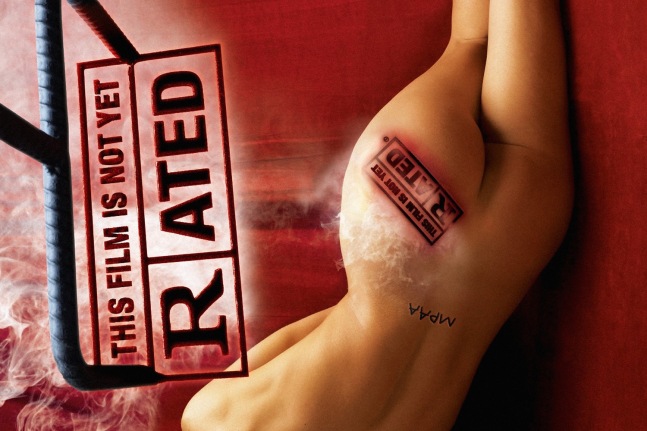With this weekends release of 50 Shades of Grey, its essential that we consider how mainstream erotica is portrayed on screen. Has it changed at all? A little bit. It’s more explicit, but the film is nothing more than a reiteration of an age old template: Smith explains how 1950’s sex films “assumed her [the female protagonsist] to be frigid”. The male lead is Mr. Grey, a strapping, young bachelor who has taken an interest in a young, unassuming virgin. He feels the need to woo her and they both find themselves in a monochromatic romantic entanglement.
One thing that can be said in favor of 50 Shades is its modern take on 21st century relationships. Anastasia, the female lead ends up abandoning the relationship for her own well being and Mr. Grey never compromises his kinks for her love. There is an evident commentary on the desaturated state of contemporary dating culture, something that finds its footing in the films title. Having said that, Anastasia’s character falls completely short of being compelling outside of her immediate relationship with Mr. Grey, which is why the film fails as a result. Its a prime example of a film that could have been presented as a feminist piece, if the female character had a more coherent voice.
Steve McQueen’s film Shame explores similar themes of loveless white-collar sexual intercourse, and does so with much more taste subtle originality. The film explores incestuous affection and sexual repression, themes that build into more heavily dramatic stakes than the ones presented in 50 Shades. So why is Shame not a hyped piece of erotica the same way 50 Shades is? The answer simply lies in its NC-17 rating [short for No Children / 17 up].
Films that are given the NC-17 rating often don’t receive a wide release, causing the general public to lose interest in them. This can result in box office failure and far worse. Consequently, film studios try their best to avoid releasing films that get an NC-17.
For more information on how age restrictions are decided, the documentary This Film Is Not Yet Rated explores what constitutes an R rating versus an NC-17 rating, and how sex is far more likely to be given the dreaded NC-17 than a film with excessive violence. Homosexual intimacy is more likely to receive an NC-17, and so is the portrayal of male genitalia. 50 Shades carefully cuts away just before we ever see Mr. Grey’s penis, whilst one of Shame‘s first shot is of Michael Fassbender completely naked.
This circles back to the core question of what exactly is wrong with Hollywood and female representation? Well the answer is quite simple. Nothing is inherently wrong with Hollywood. The problem more directly lies with the MPAA (Motion Picutre Association of America) and the board of members that decide on age restrictions. This committee of sorts, and their biased, conservative mindset has essentially resulted in a stigmatization of male and female bodies, holding each to a completely different standard.
If the MPAA were to consider female breasts as inappropriate, but male genitalia as acceptable, Hollywood would surely be releasing far more gay relationship films. At the end of the day, the arts (and yes, Hollywood is included) is a progressive, liberal place, and there isn’t any inherent homophobia that is preventing the release of LGBTQ+ releases. However, the MPAA scares off producers from wanting to invest in projects like these, because they are far more likely to receive an NC-17 rating, resulting in poor box office results.
If Hollywood wants to fix itself, it should start with the Motion Picture Association of America





I really enjoyed your blog post and critique of the MPAA, bringing to light how the issue is not just Hollywood or filmmakers, but those who produce the ratings for films. It is interesting to note that the MPAA reflects the patriarchal norms of American society, and due to your post, I am interested in doing some research about the MPAA. While I found your post enlightening in the sense that you criticized female representation as well as sexual representation in a different light by exploring the role of the MPAA, I do disagree with your assumption that Hollywood would release more gay relationship films if the standards were set differently. While Hollywood may be very liberal, I doubt that mainstream America would find these films of much interest and would not imagine that they would do well in the box office. Although there is a lot of progress being made for the LGBTQ+ community, I still find that homophobia is rampant in the nation and think that an onslaught of films depicting gay relationships at the forefront would be met with a lot of protest, rage, and little commercial success. But I guess we won’t know until it’s done!
LikeLiked by 1 person
Really, really great insight on our industry’s rating system. It gave viable, concrete solutions to the unequal /skewed representations of sexuality and gender in film.
I don’t completely agree with your perspective on Fifty Shades of Grey; I don’t think that the film could have been made into a feminist film by merely changing the one dimensionality of the female protagonist. The entire storyline is based upon the dynamics of an abusive relationship (though it is disguised as a sexually empowering romance) and I would consider that to be the film’s largest flaw. Even if Ana was more complex, the romanticization of this toxic relationship is what makes the film damaging. Both characters would have to be significantly changed in order for this movie to have positive implications for women.
LikeLiked by 1 person
-Tzuni Lopez
LikeLiked by 1 person